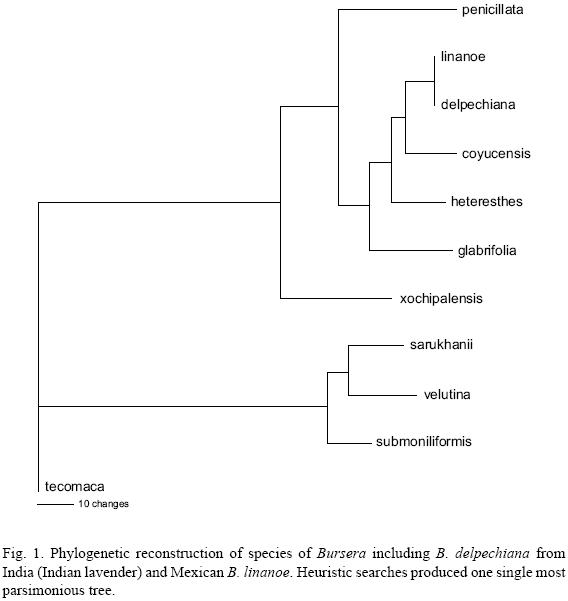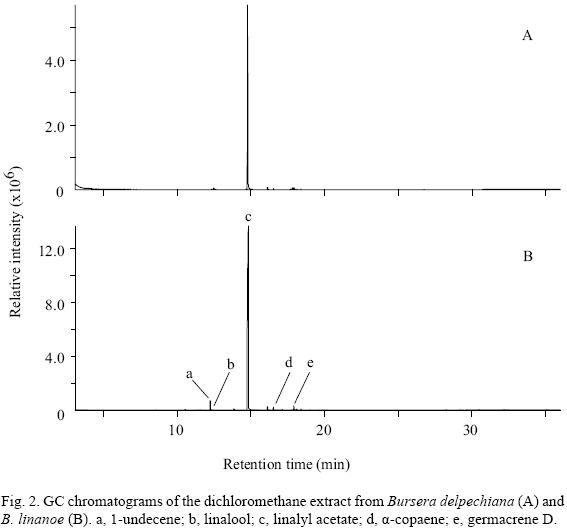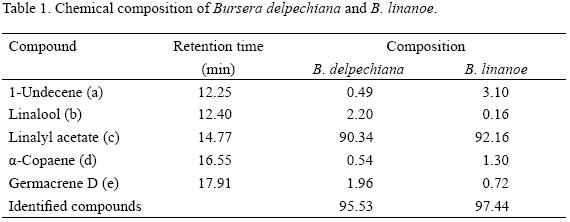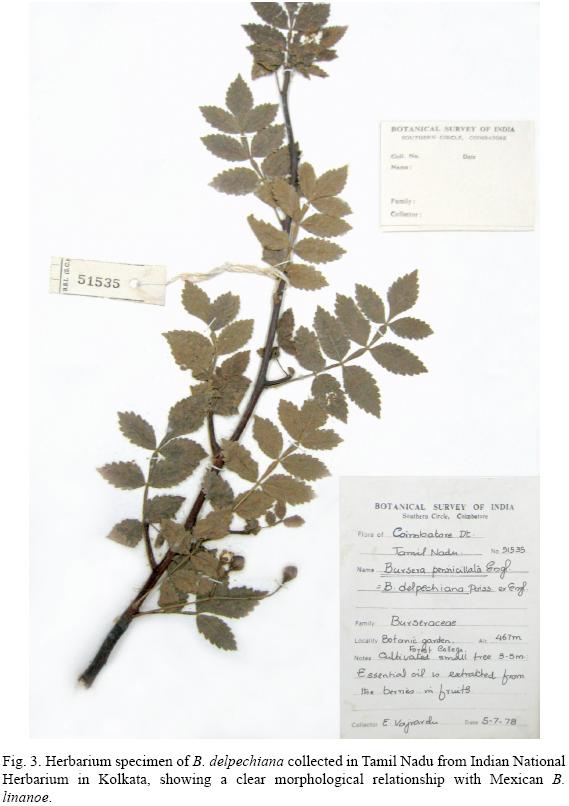Services on Demand
Journal
Article
Indicators
-
 Cited by SciELO
Cited by SciELO -
 Access statistics
Access statistics
Related links
-
 Similars in
SciELO
Similars in
SciELO
Share
Acta botánica mexicana
On-line version ISSN 2448-7589Print version ISSN 0187-7151
Act. Bot. Mex n.91 Pátzcuaro Apr. 2010
Artículos
The Mexican roots of the Indian lavender tree
Las raíces mexicanas de la lavanda de la India
Judith X. Becerra1 and Koji Noge2
1 University of Arizona, Department of Biosphere 2, Tucson AZ 85721, USA. jxb@email.arizona.edu
2 Akita Prefectural University, Department of Biological Production, Akita 010–0195, Japan. noge@akita–pu.ac.jp
Recibido en mayo de 2009
Aceptado en febrero de 2010
ABSTRACT
The tree known as Indian lavender (Bursera delpechiana, Burseraceae) is a source of linalool. it was introduced to India from Mexico at the beginning of the 20th century for the exploitation of its essential oil. Its origin from Mexico was not well understood because the name B. delpechiana has been taxonomically obsolete for many years. We used molecular, phylogenetic, and chemical data to determine which currently recognized species it belongs to. This evidence regarding the Indian Lavender Tree's identity all points to the Mexican species, Bursera linanoe. Our chemical analysis also revealed that linalyl acetate is the primary constituent of Indian Lavender oil as well as of Mexican B. linanoe rather than linalool as previously believed.
Key words: Bursera, Burseraceae, Indian lavender oil, linalyl acetate, linalool, Mexico.
RESUMEN
El árbol conocido como Lavanda de la India (Indian lavender; Bursera delpechiana, Burseraceae) es una fuente de linalol. Esta planta fue introducida en India a principios del siglo XX para extraer el mencionado aceite esencial. Su origen hasta hace poco era incierto porque el nombre B. delpechiana fue declarado obsoleto desde hace muchos años. Usamos datos moleculares, filogenéticos y químicos para determinar a qué especie reconocida pertenecen estas plantas que se encuentran en India. Las evidencias señalan que la identidad de la lavanda de la India es la especie mexicana Bursera linanoe. Los análisis químicos revelan también que el constituyente químico principal de esta especie es el acetato de linalilo y no el linalol, como se había reportado.
Palabras clave: acetato de linalilo, Bursera, Burseraceae, linalol, México.
INTRODUCTION
A plant usually identified in Asia as Bursera delpechiana Poisson ex Engl., commonly known as Indian Lavender Tree or Indian Linaloe, inhabits parts of southern India. For more than a century it has been intensively used in the perfume and pharmaceutical industry as a source of essential oils, particularly linalool. The genus Bursera Jacq. ex L. is an abundant and diversified component of the tropical dry forests in Mexico and Central America (Becerra, 2003; Becerra, 2005). As the genus is otherwise restricted to America, B. delpechiana is the most widely cultivated Bursera species elsewhere.
Yet, Bursera delpechiana is not native to India. In 1912 this tree, along with other closely related species such as B. glabrifolia (Kunth) Engl., were introduced in India in the vicinities of Bangalore in Karnata State by Scottish entrepreneurs with the purpose of commercializing their oils (Burton, 1952). Bursera delpechiana did well in the Indian environment due to its drought resistance and its cultivation spread soon to Andhra Pradesh, Thailand, and other areas. The innovation of distilling the mature fruits instead of the wood, as it had been done in Mexico, proved to be a success, giving the Indian oil a superior odor and a longer persistence. The indian oil eventually took over the international markets and its industrial exploitation in Mexico collapsed.
As time passed and taxonomical studies of the genus were conducted, the name of B. delpechiana Poisson ex Engl. became obsolete in America as it was considered synonymous first to B. penicillata (Sessé & Moc. ex DC.) Engl. (Bullock, 1936), then tentatively to B. glabrifolia (Kunth) Engl. (Mcvaugh and Rzedowski, 1965) and later to B. linanoe (La Llave) Rzed., Calderón & Medina (Rzedowski et al. 2005). However, because of confusion about its correspondence to the Mexican species, it has not been possible to establish which modern species the Indian plants belong to (Toledo, 1982). Some Indian authors have indicated that the Indian Lavender is Bursera penicillata (Mahmood Hussain et al., 1974; Somata & Uppin, 1979), a species of wide distribution in the west of Mexico. Yet their morphological descriptions do not coincide fully with descriptions of this Mexican species. However, since some degree of morphological change can be expected from the species having been for years in another environment only a more rigorous analysis could conclusively confirm the true identity of the species. Here we present molecular and chemical evidence regarding the identity of Indian Lavender.
MATERIAL AND METHODS
A small branch of an individual of B. delpechiana was collected from one of the old original plantations located at the south of Bangalore, India. For prior phylogenetic studies we had collected samples of several individuals of B. linanoe, B. penicillata and B. glabrifolia (Kunth) Engl., as well as other closely related species such as B. xochipalensis Rzed., B. heteresthes Bullock and B. tecomaca (Sessé & Moc. ex DC.) Standl. The geographic distribution of these species, as well as the localities of the samples taken can be found in Becerra & Venable (1999).
A phylogenetic tree including all of these species was reconstructed using the DNA sequences of the internal transcribed spacers (ITS1 and ITS2), the 5.8s coding region and the 5S non–transcribed region. Sequences of these regions had been already published for all species (Becerra, 2003; Becerra & Venable, 1999) except B. delpechiana from India. For this last species total DNA was isolated using the DNeasy® Plant Mini Kit (QIAGEN, Valencia, CA, USA) according to the manufacture's protocol. The partial fragments of the ITS region were amplified using the ITS1 (5'–TCCGTAGGTGAACCTGCGG–3') and 26SE (5'–TAGA–ATTCCCCGGTTCGCTCGCCGTTAC–3') primers. PCR was performed in a 30 µl volume containing 15 µl of EconoTaq® PLUS GREEN 2×Master Mix (Lucigen® Corp.), 1 µm of each primer and 1 µl of template DNA. The PCR amplification was carried out as follows: an initial step of 2 min at 94 °C, followed by 30 cycles with denaturation at 94 °C for 30 s, annealing at 48 °c for 30 s and extension at 72 °C for 1 min. After the final cycle, the products were extended for 5 min at 72 °C. The 5S–NTS region was amplified using the primers 5SF (5'–GAGAGTAG–TACWWSGATGGG–3') and 5SR (5'–GGAGTTCTGAYGGGATCCGG–3') described in cronn et al. (1996). We used the same reaction mixture as for the ITS reaction. The amplification program was: hold at 94 °C for 2 min; 30 cycles of 94 °C for 30 s, 50 °C for 30 s, and 72 °C for 10 s; extend at 72 °C for 5 min. The amplified products were purified by QIAquick® PCR Purification Kit (QIAGEN). The DNA sequences were analyzed with an ABI 3730xl DNA analyzer (Applied Biosystems Inc., Foster City, CA, USA) at the Genomic Analysis & Technology Core, University of Arizona. Sequences were aligned with the computer program Sequencher 4.4. Phylogenies were inferred from the sequence matrix using parsimony analysis with PAUP 4.0b10 (Swofford, 2002). Heuristic searches were used with the same assumptions as in Becerra & Venable (1999).
To confirm DNA and phylogenetic results concerning the closeness of the Indian B. delpechiana Poisson ex Engl. and B. linanoe (La Llave) Rzed., Calderón & Medina, we performed chemical analysis on these plants. A small piece of a branch with leaves of B. linanoe, and another piece of B. delpechiana were extracted in dichloromethane. Their volatile chemistry was analyzed using gas chromatography–mass spectrometry (GC–MS). GC–MS analysis was carried out by an Agilent 6890N gas chromatograph linked to an Agilent 5975B mass spectrometer operated at 70 eV using a HP–5MS capillary column (Agilent Technologies, 30 m x 0.25 mm i.d., 0.25 µm in film thickness) with helium carrier gas at 1.2 ml/min in splitless mode. The oven temperature was programmed from 30 °C to 300 °C at 10 °C/min with an initial 4 min hold, and then held at 300 °C for 5 min. All compounds were identified by comparing their GC retention times and mass spectra with those of authentic standards.
RESULTS
DNA sequences of the indian B. delpechiana were all identical to those of B. linanoe. even the fast evolving 5S NTS region, which gives a good level of resolution at the species level in Bursera was identical for both species. Because of this, B. delpechiana and B. linanoe came together in the reconstructed phylogenetic tree (fig. 1). all other species, including B. penicillata were relatively distant from them.

Chemical components of B. delpechiana were also quite similar to those of B. linanoe (fig. 2). In both, the compound with the highest relative abundance (more than 90%) was linalyl acetate (Table 1). All the other minor compounds in B. delpechiana were present in B. linanoe at very similar abundances.


DISCUSSION
Molecular, phylogenetic, and chemical results leave little doubt about B. linanoe being the Mexican species taken to India in 1912 and subsequently there known as B. delpechiana (fig. 3). Not only are the examined molecular sequences of the DNA the same but these species also share the same chemical compounds.

Previous chemical analyses using steam distillation have identified linalool as the major natural chemical component of the leaves and fruits of the Indian B. delpechiana (Nargaraja & Farooqi, 1989; Mahmood Hussain et al., 1974; Somatta & Uppin, 1979). Our analysis shows that it is actually linalyl acetate. Linalyl acetate is known to change into linalool by thermal hydrolysis during steam distillation (Reverchon & Della Porta 1995; Noge et al., 2010). We extracted our samples in dichloromethane in cold conditions (4 °C). This is probably the reason for the discrepancy between our results and the published data. Thus, we conclude that linalyl acetate is the natural component of B. linanoe (and B. delpechiana).
In previous studies, 65 of the 82 Bursera species from Mexico have been chemically analyzed, including species such as B. penicillata and B. glabrifolia. The major component of B. penicillata is β–phellandrene, while B. glabrifolia produces high amounts of germacrene D and α–pinene (Becerra, 2007; Becerra et al., 2009). Thus, these two species are chemically quite different from the indian lavender. Furthermore, none of the 65 Bursera species analyzed except B. linanoe seem to produce linalyl acetate. Given the high abundance of this compound, it could thus be considered a chemotaxonomic trait for this species.
B. linanoe is a narrow endemic to the tropical dry forest in the south of Mexico in the states of Puebla, Oaxaca, Guerrero and Morelos (Becerra & Venable, 2008). The introduction of this species to India and its subsequent commercialization there has had important consequences for the status of this species in Mexico. First, exploitation of the plant for its oil diminished in Mexico because the quality of the Indian oil was higher. Essential oil is still extracted from the Mexican trees, along with other Bursera species, but only at an artisanal level (Toledo, 1982). Its wood is also used to make crafts. Yet, in contrast with Indian plantation cultivation, the Mexican oil has always been extracted from wild plants. This, as well as its exploitation for wood crafts have caused a decline in the abundance of this species, to the point of now being nearly extinct in some localities (Espinosa–Organista, 2007). Successful commercialization and extraction of higher quality oil in India has relaxed commercial extraction in its native range, hence improving its conservation status in Mexico.
ACKNOWLEDEMENTS
We thank Leif Abrell, University of Arizona for the generous gift of chemicals, Boris Vrskovy for providing the Indian literature, Fredd Dürr for collection of the B. delpechiana sample, and Larry Venable for reading a prior manuscript and giving helpful suggestions. The Indian National Herbarium in Kolkata allowed us to take photographs of herbarium specimens of B. delpechiana. This work was supported by a National Science Foundation CAREER grant, a Young Investigator Award from the Beckman Foundation, and a grant from the Vice President for Research and the Colleges of Science and Agriculture of the University of Arizona to J.X.B.
LITERATURE CITED
Becerra, J. X. 2003. Evolution of Mexican Bursera (Burseraceae) inferred from ITS, ETS and 5S nuclear ribosomal DNA sequences. Molec. Phylog. Evol. 26: 300–309. [ Links ]
Becerra, J. X. 2005. Timing the origin and expansion of the Mexican tropical dry forest. Proc. Natl. Acad. Sci. U.S.A. 102(31): 10919–10923. [ Links ]
Becerra, J. X. 2007. The impact of herbivore–plant coevolution on plant community structure. Proc. Natl. Acad. Sci. U.S.A. 104(18): 7843–7488. [ Links ]
Becerra, J. X. and D. L. Venable. 2008. Sources and sinks of diversification and conservation priorities for the Mexican tropical dry forest. PLoS ONE 3(10): e3436. [ Links ]
Becerra, J. X., K. Noge & D. L. Venable. 2009. Macroevolutionary chemical escalation in an ancient plant–insect arms race. Proc. Natl. Acad. Sci. U.S.A. 106(43): 18062–18066. [ Links ]
Becerra, J. X. & D. L. Venable. 1999. Nuclear ribosomal, DNA phylogeny and its implications for evolutionary trends in Mexican Bursera (Burseraceae). Amer. Jour. Bot. 86: 1047–1057. [ Links ]
Bullock, A. A. 1936. Notes on the Mexican species of the genus Bursera. Bull. Misc. Inf. Kew 1936: 346–387. [ Links ]
Burton, R. W. 1952. The linaloe tree (Bursera delpechiana Poisson): An introduction into the flora of India. J. Bombay Nat. Hist. Soc. 52: 116–120. [ Links ]
Cronn, R. C., X. Zhao, A. H. Paterson & J. F. Wendel. 1996. Polymorphism and concerted evolution in a tamdemly repeated gene family: 5S ribosomal DNA in diploid and allopolyploid cottons. J. Mol. Evol. 42: 685–705. [ Links ]
Mahmood Hussain, A. M., K. N. Subramanian & J. Madhavan Nair. 1974. Some observations on Bursera penicillata (DC) Engl. (B. delpechiana Poisson ex Engl). Indian Forester 100: 315–319. [ Links ]
McVaugh, R. & J. Rzedowski. 1965. Synopsis of the genus Bursera L. in western Mexico, with notes on the material of Bursera collected bye Sessé & Mociño. Kew Bull. 18: 317–382. [ Links ]
Noge, K., N. Shimizu & J. X. Becerra. 2010 (R)–(–)–Linalyl acetate and (S)–(–)–Germacrene D from the leaves of Mexican Bursera linanoe. Natural Product Communications. in Press. [ Links ]
Nargaraja, C. & A. A. Farooqi. 1989. Studies on the seed germination as influenced by various pre–treatments in Bursera. Indian Perfumer 33(1): 48–53. [ Links ]
Espinosa–Organista, D., G. Montaño & F. Becerril. 2008. Qué son y dónde viven los copales?. Purata, S. E. (ed.). Uso y manejo de los copales aromáticos: resinas y aceites. Comisión Nacional para el Conocimiento y Uso de la Biodiversidad/Red de Aprendizaje para el Intercambio y Sistematización de Experiencias hacia la Sustentabilidad. México. D.F. 60 pp. [ Links ]
Reverchon, E. & G. Della Porta. 1995. Supercritical CO2 extraction and fractionation of Lavender essential oil and waxes. J. Agric. Food Chem. 43: 1654–1658. [ Links ]
Rzedowski, J., R. Medina Lemos & G. Calderón de Rzedowski. 2005. Inventario del conocimiento taxonómico, así como de la diversidad y del endemismo regionales de las especies mexicanas de Bursera (Burseraceae). Acta Bot. Mex. 70: 85–100. [ Links ]
Somatta, K. & S. F. Uppin. 1979. Indian Lavender (Bursera penicillata (D.C.) Engl. A review. Indian Forester 105: 859–863. [ Links ]
Swofford, D. L. 2002. PAUP* 4.0 beta version: phylogenetic analysis and using parsimony (and other methods). Sinauer Associates Inc., Sunderland, Massachusetts. [ Links ]
Toledo, C. A. 1982. El género Bursera en el estado de Guerrero. Tesis de licenciatura en Biología. Facultad de Ciencias, Universidad Nacional Autónoma de México. México, D.F. 182 pp. [ Links ]














